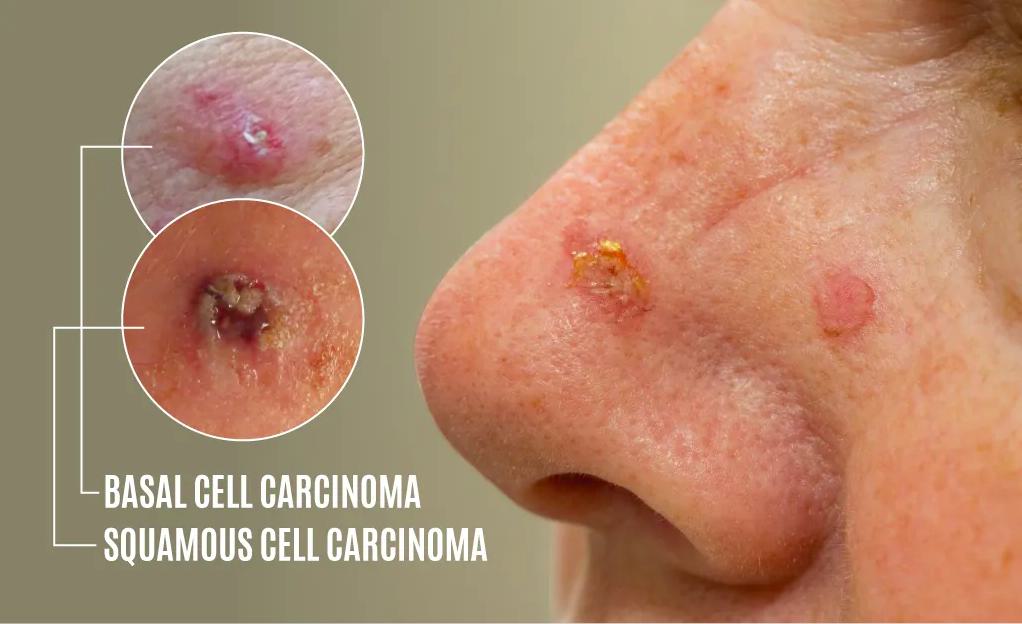Skin cancer is among the most common types of cancer worldwide, and while melanoma often receives more public attention, the majority of skin cancers actually fall under the category of non-melanoma skin cancer. These cancers, though typically less aggressive than melanoma, can still cause significant health concerns if not detected and treated promptly.
Understanding non-melanoma skin cancer is crucial because early detection and proper management can lead to highly favorable outcomes. This guide provides an in-depth look at its definition, types, causes, symptoms, treatments, prevention strategies, and the latest research, helping patients and families stay informed and proactive about skin health.
Definition and Overview
Non-melanoma skin cancer (NMSC) refers to all types of skin cancers that are not melanoma. The two most common forms are basal cell carcinoma (BCC) and squamous cell carcinoma (SCC). Unlike melanoma, which develops from pigment-producing cells, non-melanoma cancers originate from the skin’s keratinocytes. These cancers are generally slow-growing and have a lower chance of spreading to other parts of the body.
Types of Non-Melanoma Skin Cancer
- Basal Cell Carcinoma (BCC): The most common type, often appearing as a pearly bump or flat lesion on sun-exposed skin.
- Squamous Cell Carcinoma (SCC): Typically appears as a scaly red patch, open sore, or thickened skin lesion. It has a higher risk of spreading compared to BCC.
- Less Common Types: Merkel cell carcinoma and cutaneous lymphoma are rarer but more aggressive forms of non-melanoma skin cancer.
Causes and Risk Factors
The primary cause of non-melanoma skin cancer is prolonged exposure to ultraviolet (UV) radiation from the sun or tanning beds. Risk factors include:
- Fair skin, light-colored eyes, and hair
- History of frequent sunburns
- Weakened immune system
- Exposure to carcinogenic chemicals such as arsenic
- Age over 50, though younger individuals are increasingly affected
Symptoms and Early Warning Signs
Recognizing symptoms early is essential for effective treatment. Common signs of non-melanoma skin cancer include:
- Persistent sores that do not heal
- Red, scaly patches of skin
- Pearly or waxy bumps
- Lesions that bleed easily or form crusts
- Rough, thickened areas on sun-exposed skin
Diagnosis
Diagnosis usually begins with a clinical examination by a dermatologist. If cancer is suspected, a skin biopsy is performed to confirm the type and stage of the disease. Imaging tests may be used in rare cases to determine if the cancer has spread.
Treatment Options
Treatment depends on the type, size, and location of the cancer:
- Surgical removal (excision or Mohs surgery) – the most effective option for complete removal.
- Cryotherapy – freezing cancerous tissue.
- Radiation therapy – often used for patients who cannot undergo surgery.
- Topical treatments – creams or gels that destroy cancer cells.
- Photodynamic therapy (PDT) – light-based treatment for superficial cancers.
Prevention and Lifestyle Recommendations
While non-melanoma skin cancer is highly treatable, prevention is always better. Key strategies include:
- Limiting sun exposure, especially during peak hours (10 a.m. – 4 p.m.)
- Wearing protective clothing, hats, and sunglasses
- Applying broad-spectrum sunscreen (SPF 30 or higher) daily
- Avoiding tanning beds
- Regular skin self-examinations and professional check-ups
Prognosis and Survival Rates
The prognosis for non-melanoma skin cancer is generally excellent, especially when diagnosed early. Basal cell carcinoma has a cure rate of over 95%, while squamous cell carcinoma is also highly treatable if caught before spreading. Advanced cases require more aggressive treatment, but survival rates remain high compared to melanoma.
Latest Research and Innovations
Recent advances in non-melanoma skin cancer research focus on targeted therapies, immunotherapy, and advanced surgical techniques. Drugs that enhance the body’s immune response to cancer are showing promising results, while ongoing studies are improving early detection through artificial intelligence and genetic testing.
Coping and Support for Patients
A cancer diagnosis, even for non-melanoma skin cancer, can cause emotional distress. Patients are encouraged to:
- Join support groups for skin cancer survivors
- Discuss concerns openly with healthcare providers
- Adopt healthy lifestyle habits for improved recovery
- Seek counseling or mental health support when needed
Conclusion
Non-melanoma skin cancer may not be as widely discussed as melanoma, but it is the most common form of skin cancer worldwide. With early detection, effective treatments, and preventive care, most cases can be managed successfully. Staying informed, practicing sun safety, and seeking medical advice at the first signs of suspicious skin changes are essential steps in reducing risks and ensuring long-term skin health.
FAQ
1. What is the difference between melanoma and non-melanoma skin cancer?
Melanoma arises from pigment-producing cells (melanocytes) and is more aggressive, while non-melanoma skin cancer usually develops from keratinocytes and is less likely to spread.
2. Is non-melanoma skin cancer deadly?
Most cases are not life-threatening if detected and treated early. However, advanced squamous cell carcinoma and rare types can become serious.
3. Can non-melanoma skin cancer come back after treatment?
Yes, recurrence is possible, particularly if the cancer was not fully removed or if sun exposure continues without protection.
4. How common is non-melanoma skin cancer?
It is the most common cancer worldwide, with millions of new cases diagnosed each year.
5. What is the best way to prevent non-melanoma skin cancer?
Consistent sun protection, avoiding tanning beds, and routine skin checks are the most effective preventive measures.

